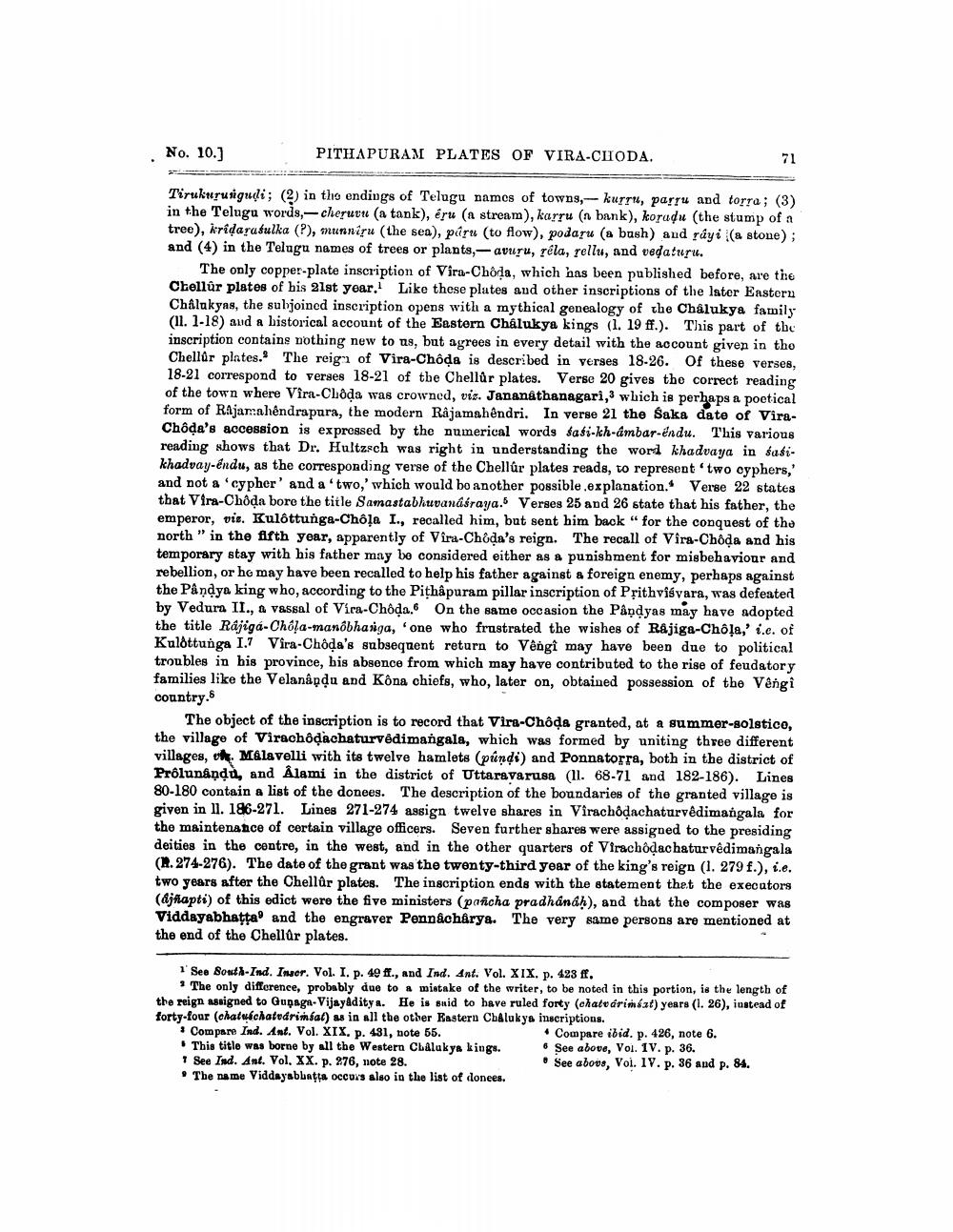________________
No. 10.)
PITHAPURAM PLATES OF VIRA-CHODA.
Tirukteunigudi; (2) in the endings of Telugu names of towns,- kurri, parru and torra; (3) in the Telugu words, cheruvu (a tank), éru (a stream), karru (n bank), korudu (the stump of a tree), kridarafulka (P), munniru (the sea), púru (to flow), podaru (a bush) aud růyi (a stone); and (4) in the Telugu names of trees or plants, -avuru, réla, rellu, and vedaturu.
The only copper-plate inscription of Vira-Choda, which has been published before, are the Chellûr plates of his 21st year. Like these plates and other inscriptions of the later Eastern Chalukyas, the subjoinod inscription opens with a mythical genealogy of the Chalukya family (11. 1-18) avd a historical account of the Eastern Chalukya kings (1. 19 ff.). This part of the inscription contains nothing new to us, but agrees in every detail with the account given in the Chellar plates. The reign of Vira-Chôda is described in verses 18-26. Of these verses, 18-21 correspond to verses 18-21 of the Chellûr plates. Verse 20 gives the correct reading of the town where Vira-Choda was crowned, viz. Jananathanagari,3 which is perhaps a poetical form of Rajamahendrapara, the modern Rajamahêndri. In verse 21 the Saka date of ViraChôda's accession is expressed by the numerical words sasi-kh-ambar-endu. This various reading shows that Dr. Hultzsch was right in understanding the word khadvaya in sasikhadvay-éndu, as the corresponding verse of the Chellúr plates reads, to represent two cyphers,' and not a 'cypher' and a two,' which would bo another possible.explanation. Verse 22 states that Vira-Chôda bore the title Samastabhuvanaśraya. Verses 25 and 26 state that his father, the emperor, vis. Kulôttunga-Chôļa I., recalled him, but sent him back " for the conquest of the north " in the fifth year, apparently of Vîra-Choda's reign. The recall of Vira-Chôda and his temporary stay with his father may be considered either as a punishment for misbehaviour and rebellion, or he may have been recalled to help his father against & foreign enemy, perhaps against the Pandya king who, according to the Pithâpuram pillar inscription of Pșithvisvara, was defeated by Vedura II., & Vassal of Vira-Choda. On the same occasion the Påndyas may have adopted the title Rájiga-Chola-manôbhasiga, one who frustrated the wishes of Rajiga-Chôļa,' i.e. of Kulottunga 1.7 Vira-Chôda's subsequent return to Vêngi may have been due to political troubles in his province, bis absence from which may have contributed to the rise of feudatory families like the Velanâ du and Kôna chiefs, who, later on, obtained possession of the Vêngi country.
The object of the inscription is to record that Vira-Chôda granted, at a summer-golstico, the village of Virachôdachaturvedimangala, which was formed by uniting three different villages, ut Malavelli with its twelve hamlets (pundi) and Ponnatorra, both in the district of Prôlunândò, and Alami in the district of Uttaravarusa (11. 68-71 and 182-186). Lines 80-180 contain a list of the donees. The description of the boundaries of the granted village is given in II. 186-271. Lines 271-274 assign twelve shares in Virachôdachaturvedimangala for the maintenance of certain village officers. Seven further shares were assigned to the presiding deities in the centre, in the west, and in the other quarters of Virachôdachaturvedimangala (A. 274-276). The date of the grant was the twenty-third year of the king's reign (1. 279 f.), i.e. two years after the Chellûr plates. The inscription ends with the statement that the executors (&jfiapti) of this edict were the five ministers (pañicha pradhanah), and that the composer was Viddayabhatta and the engraver Pennacharya. The very same persons are mentioned at the end of the Chellur plates.
* See Sonth-Ind. Inger. Vol. I. p. 42 ff., and Ind. Ant. Vol. XIX. p. 423 ff.
• The only difference, probably due to a mistake of the writer, to be noted in this portion, is the length of the reign assigned to Gunaga-Vijayaditya. He is suid to have ruled forty (chatráriméat) years (1. 26), instead of forty-four (chatuchatedrimsal) as in all the other Eastern Chalukya inscriptions. Compare Ind. Ant. Vol. XIX. p. 431, note 55.
• Compare ibid. p. 426, note 6. . This title was borne by all the Western Chalakya kings. • See above, Vol. IV. p. 36. * See Ind. Ant. Vol. XX. p. 276, note 28.
• See abovs, Vol. IV. p. 36 and p. 84. • The name Viddayabbatta occurs also in the list of donees.




